Art World
In Tribute to Trees, This Year’s Serpentine Pavilion Helps Irrigate London’s Hyde Park
The award-winning architect brought inspiration from his native West Africa to London's gardens.

The award-winning architect brought inspiration from his native West Africa to London's gardens.

Caroline Goldstein

West African architect Diébédo Francis Kéré’s tree-inspired pavilion will open to the public this Friday, as the latest presentation of the Serpentine Gallery’s design commission. Kéré, whose architectural firm is based in Berlin, is the first African architect selected for the project, now in its 17th year. Kéré was chosen in February by the Serpentine’s artistic director Hans-Ulrich Obrist, CEO Yana Peel, and starchitect advisers David Adjaye and Richard Rogers. The project was initiated in 2000 under then director Julia Peyton-Jones, as a platform for international architects and designers to create a temporary structure for public interaction and use. Past participants have included Frank Gehry, Zaha Hadid, Olafur Eliasson, and Daniel Libeskind.
The structure is inspired by the baobab tree, a species commonly found in the architect’s native village of Gando in Burkina Faso. A lattice-steel trunk rises into a canopy-like roof made of timber slats arranged in a triangular formation. The walls echo the triangular pattern, and are painted in a deep indigo blue—a color often worn during times of celebration in Burkinabe culture, and which the architect chose to signify the importance of his first UK-based building.

Kéré’s Serpentine Pavilion in London’s Hyde Park. © Kéré Architecture, photography © 2017 Iwan Baan.
The building was designed to respond to the temperamental English climate, and to be a beneficial addition to the gardens. The center of the roof opens to a well, which is designed to funnel and catch rainwater—creating both a waterfall during London’s notoriously inclement weather and a sustainable method to irrigate the park. The pavilion will be open June 23–October 8, with an array of public programs, events, and activities scheduled.